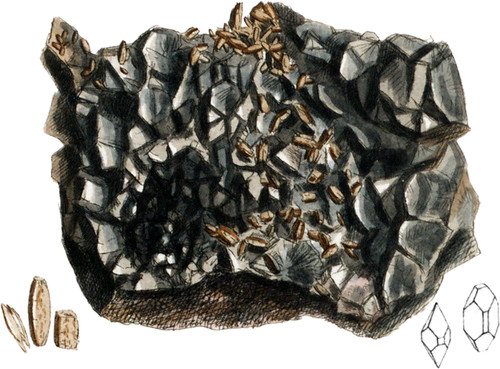 Enlarge
Enlarge
Exotic Mineralogy
Scheelate of Lead
- Syn.
- Bleischeelin (scheelsaures oxydulertes Blei.
- Tungstate of Lead. Heüland in Annals of Philos. 12, 454.
The present mineral was communicated by H. Heüland Esq. as a new ore of lead, from Zinwald in Bohemia, with the German name Bleischeelin, and supposed to have heen examined by Prof. Lampadius. I have not yet met with any published account of such a mineral,* or any analysis of a lead ore containing scheelic (Tungstic) acid: it is at present too rare in this country to admit of its being examined chemically, except by the aid of the blowpipe, and the number of experiments that an accidentally detached crystal has afforded, even with that instrument, have been but few. When first exposed to the flame it decrepitates ; when powdered, it melts upon charcoal into a black slaggy brittle globule, without exhibiting any traces of lead; but with soda and charcoal it is reduced to the metallic state, with borax it acts much in the same way that molybdate of lead does, producing with a small portion an opaque white globule mixed with blue clouds, which upon the addition of more borax becomes transparent, and of a pale brown colour. As the molybdate of lead is easily reducible upon charcoal, the result of the first experiment seems sufficient to distinguish them. The forms most common to scheelate of lead are elongated square prisms, square acute pyramids generally truncated and double pointed foursided crystals whose sides are curved, and the points sometimes truncated, the terminal angles of the pyramids are in some instances replaced by small brilliant facetts, from the enlargement of which would result acute octahedrons, and indeed there are upon the specimen two minute octahedrons so produced, with fiat shining feces and sharp points. None of the crystals exhibit a foliated structure internally, but are ragged upon the Surface, with sparkling facetts parallel to the modification last mentioned. The internal fracture is ragged without much lustre. The acute form of the crystals distinguishes them from the more usual ones of Molybdate of Lead; but I have seen similar ones among the masses of tabular crystals of that species from Carinthia; they, however, are immediately reduced to Lead upon Charcoal.
The gangue of Scheelate of Lead is Mica, upon crystals of Quartz, with Scheelate of Iron (Wolfram) in hexahedral prisms, composed of concentric coats. Mr. Heüland has one specimen besides that figured; it is of a darker colour, and the crystals assume more the form of spiculæ.
- * Except De Lametherie’s name for Molybdate of Lead.

